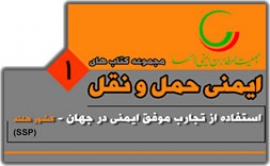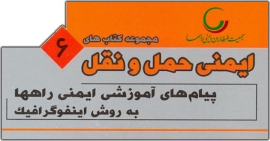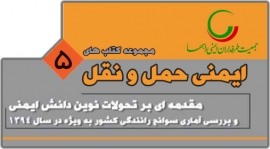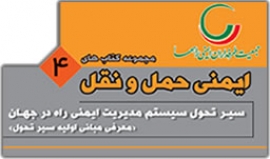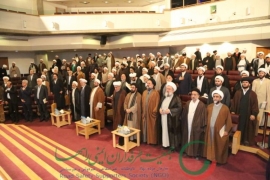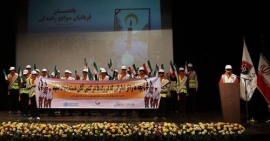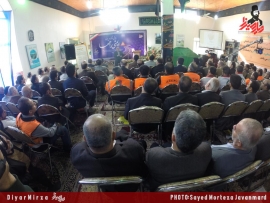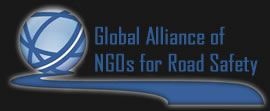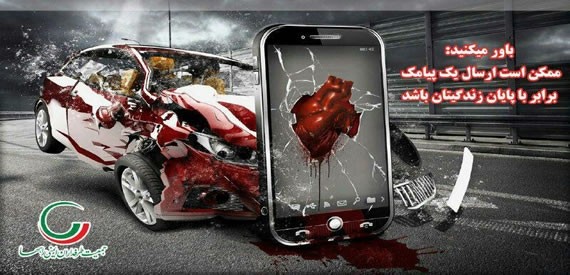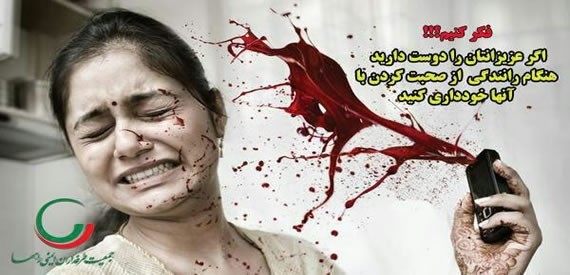Nationwide Conference on Safety Alliance with Participation of the Clergy
In line with the cultural and social programs of the Road Safety Supporters Society (RSSS) for reducing traffic injuries and fatalities and in order to prevent the significant overt and covert human, social and economic losses in the country, the nationwide grand conference of “Safety Alliance” was held with the presence and participation of the clergy, ulema and relevant authorities.
According to the Public Relations Office of the Road Safety Supporters Society (RSSS) Hojjatoleslam Mousavi Moqaddam Parliamentary and Provincial Affairs Deputy at IRIB, announced readiness of the ulema and clergy for supporting RSSS and its goals. He said many Quranic verses are available about enjoining the good and paving the way for good deeds a manifestation of which could be the issue of building a healthy society.
He stressed that today subjects that enjoy Quranic status have more objectivity, because at present concepts have been further expanded and the elements of time, place and space compression, have created a new era for human beings.
Mousavi Moqaddam referred to ‘speed’ as the inherent and inseparable feature of the the said mentioned elements and said; “With the development of technology we proceed in a way that in future our children would blame us for how it took us several hours to take a distance, because speed is an important component of time and in all areas everything is affected by speed.”
He added, “If we disregard the question of speed and fail to formulate plans at present or in future, we will be faced with problems that are caused by acceleration and speed such as traffic crashes.”
Mousavi Moqaddam further said: “If we fail to regulate speed and move along accordingly, we will face tremendous backwardness and in that case we will be put under a passive condition.”
The IRIB official further remarked: “The speed of the developments in our country is not in conformity with the speed of irregularities and in terms of speed of development we have been affected by backwardness while with regard to the speed of abnormalities we are ahead of some other countries and if this issue is not resolved we will definitely face chaos and confusion.”
He stated: “We have great assets in our possession, about one-fourth of the Quranic verses are in relation to prevention and observance and this in turn is a great reference for building culture and making our society healthy. For the same reason some countries were faced with problems with regard to the soft war in Iran, because we enjoy strong religious beliefs.”
As for the media, Mousavi Moqaddam said: “Definitely among all the media of the world, the pulpit media which is face to face and the audience have confidence in it, enjoys more influence. Here I would like to quote a statement from Martyr (Morteza) Motahhari (a senior religious scholar who was assassinated early after the 1979 Islamic Revolution) who said: ‘I wonder why the ulema do not issue fatwas about some issues.’ For this reason, the clergy should participate in many affairs and use the pulpit media in their possession.”
He further noted: “If we fail to have new answers to new questions we will be faced with crisis, perhaps for the new technology, new grounds should be prepared.”
In conclusion, Mousavi Moqaddam pointed to the power of emotions in the field of traffic crashes and said: “Many issues, especially traffic crashes should be linked to the people’s emotions and we must impress the people with advertisement, animation, etc.”
Saeed Moeidfar, Advisor to the Road and Urban Development Ministry in Social Affairs, referring to the fact that in Iran weekly traffic crash losses are equivalent to the fatalities of a wide-bodied aircraft crash, said: “43% of those killed in traffic crashes are between 20 and 40 years old and men who lose their lives are 3.4% more than women which means that the age and gender ratio of the population who die in traffic crashes are gradually changing and this is alarming.”
Moeidfar cited the important role three elements of roads, vehicles and human error play in traffic crashes and noted that behavior of the drivers is a cultural element, while the impact of cultural factors, even with regard to the road and vehicle, is comprehensive.
He stressed: “To the same extent that safety in the society is taken into consideration, to the same extent we feel responsibility in road building and auto manufacturing.”
The advisor to the Minister of Road and Urban Development further remarked that the issue of safety should be observed by all the people involved in road safety and called for further attention to the issue of safety.
At the beginning of the conference, RSSS President Mohammad Bokharaei by mentioning that this is the fourth grand nationwide conference on “Safety Alliance” which is being held on the eve of the New Year, said: “So far three grand nationwide ‘Safety Alliance’ conferences have been held with the presence of three effective groups of professional drivers, socially active women and students with the participation of those involved in safety in scientific and executive fields.”
Bokharaei said the pivotal slogan of the current conference is “recommending safety, enjoining to good” and added that transportation is the platform for economic development, but today transportation is faced with safety challenge and traffic crashes.
Saying that in 1384 (2005/06) the number of traffic crash deaths in the country was 28 thousand people, he said by the end of 1393 (2014/2015), the figure dropped to 17 thousand, but the point is that even one death in traffic crashes is high.
The RSSS head while referring to the fact that each year 1.2 million people lose their lives in traffic crashed in the world noted that Iran constitutes one percent of the world population but its share of traffic crash casualties is 40% more than the average while 24% of the casualties are women.
He reminded that annually 700 thousand traffic crashes occur in the country and one-third of hospital beds are allocated to the victims of driving accidents to the extent that according to the estimates by 1399 (2020/2021), an average 25% of the health budget of the countries would go to victims of traffic crashes.
Bokharaei added that annually over 250 thousand households are driven towards poverty as a result of traffic crashes, adding that one-third of the victims are married and this means that annually 6000 women lose their patrons.
The RSSS head regarded human error responsible for 70% of traffic crashes and said in 1392 (2013/14), some 4168 pedestrians lost their lives in traffic crashes while 22.3% of the crashes are caused by motorcyclists.
According to the official, 300 thousand people are injured in traffic crashes annually of which 30 thousand become disabled for life.
While inviting people to further observe safety regulations in driving, Bokharaei stressed that the clergy and seminary students should be designated as safety ambassadors.
It should be noted that in this conference Adib Yazdi, a member of the Board of Trustees of the Road Safety Supporters Society, also addressed the conference.
Do Not Blame the Victims!
From mid-90’s widespread changes have occurred in the theoretical principles and executive policies for road safety which, despite its development and completion in the later decades, these principles were applied almost in all the developed and industrialized countries.
The origin of this theoretical-executive thinking took shape in Sweden which is also considered one of the most successful countries in the field of promotion of road safety in recent decades. This program dubbed ‘Vision Zero” is known as a casualty and death free landscape in road traffic and is indicative of the backdrop of a safe future in which despite the occurrence of accidents no one will be killed or disabled in traffic accidents. This vision was first raised in Sweden in 1995 and in the cosecutive years, i.e. 1997 and 1998 was approved by the Swedish Parliament as the executive basis for management of road safety and afterwards was implemented by many other countries.
The most important feature of this approach and line of thinking is the revision in responsibilities caused by driving accidents and death of the people which began with the motto “Don’t blame the victims”.
On the basis of this thinking transportation is a cross-sectoral and integrated system and those who design, manage and operate components of the transportation system, such as car manufacturers, transportation companies and agents, politicians, legislative authorities and, finally, police, etc. are mainly responsible for the driving accidents and deaths. But before that evolution and policy revision, and similar to what is currently in common in our country, almost all the responsibility of traffic accidents is shouldered by the person using the road or in other words the victims of the road crashes.
Is Death the Penalty for A Traffic Mistake by the User!?
Basically, the road transportation system has not been based on this reality that human beings are not machines and sometimes they may be affected by wrong feelings or mistakes and to sum it up: “man is fallible”. In the meantime, we know in many cases small and simple mistakes may result in the death of road users. For this same reason, today and after almost two decades, studies and macro investments in the field of automation of road navigation and use of intelligent systems in driving vehicles have been put on the agenda of many research centers and producers (including in our country).
The VZ theory emphasizes on the point that all the constituent factors of the transportation system are interconnected, and have mutual interactions. Fatalities or severe injuries mean that the components of the road transportation system have not functioned properly.
This new systematic outlook has brought about changes in the executive policies and programs of road safety and has left great emphasis on the coordination of factors, including the design of the automobile and the road environment based on behavioral and physical limitations of human beings.
This reality can never be denied that first of all humans are fallible and secondly, traffic accidents cannot be completely prevented; therefore transportation system should be designed and regulated in a way that each simple traffic mistake by the people will not be responded or punished by deaths or severe injuries.
Evolution of Safety Knowledge and Literature in the World
During the past two decades and in many countries, particularly in the industrial world and even some developing countries the road safety condition has been completely brought under control. Moreover, the issue of road safety has become a fully scientific topic and today widespread and formulated knowledge and experiences exist in the world in this regard. In addition to effectively reducing road fatalities they have also developed overall and fundamental changes in the thinking, strategy and executive programs of promoting road safety, and blocked the way to any operations based on trial and error. Naturally, failure to use the global knowledge and experience in the field of road safety in our country will have no outcome other than material and mental losses. It will also mean the loss of thousands of human lives per year and increase in the number of the poor and households without breadwinners.
As it was mentioned, among experiences and successful programs on road safety over the past two decades, reference can be made to Sweden’s Vision Zero or the Netherlands Sustainable Safety Program. Meanwhile, in March 2010 the United Nations General Assembly in Resolution 64/255 announced 2011 to 2020 the Decade of Action for Road Safety to improve global road safety. The mission was followed by the World Health Organization (WHO) which in cooperation with the United Nations Road Safety Collaboration published the executive program on promotion of safety in that decade as a guideline for the use of all countries of the world. The full text of the report was published on the website of the Road Safety Supporters Society and is at the disposal of those interested.
In brief, it can be said that the theoretical principles of the new global road safety policies are based on the two main bases:
First application of the deterrent approach and proactive approach for the prevention and control of unsafe and high-risk human behaviors and second designing and regulating the transportation system as such that it would have the capacity of generosity and accountability to the behavioral and physical shortcomings of human beings.
Therefore, in modern road safety thinking and literature, first the responsibility of the road accidents and creation of a safe traffic should not only be shouldered by the users but rather those who design, manage and control the transportation system are mainly responsible for driving accidents and fatalities. Secondly, the main axis in the compilation of new road safety policies should be inclined towards human beings and paying attention to their physical and behavioral restrictions.
Hence in the formulation of safety programs first physical vulnerability of human beings in traffic accidents should be considered and accepted by relevant authorities, and second attention should be paid to the limitation of the human behavioral capacity (the fact that human beings are fallible), and third should consider limitations and shortcomings of human behavior (for example, the fact that human beings are not always committed to rules and regulations).
The fundamental principles and foundation of the universal program for safety decade of the United Nations is based on the same thinking and has been compiled on the basis of the safe system approach. In this method, the goal is to make the road transportation system more tuned with human errors and pay attention to the physical vulnerability of human beings. This principle begins with the acceptance of the reality that human errors and consequently road accidents are unavoidable and cannot be completely avoided. Therefore, the objective of the safe system is that in road accidents there would be no major injuries or they would be minimized and attention would be paid to the human physical restrictions (especially the kinetic energy of human body) and it will be considered as the main and important basis in designing of the road transportation system.
In this regard, it is noteworthy to know:
• Many people, if driving in a car with 30 km/h speed, will survive in car accident
• Many people, if driving in a car with 50km/h speed, will be killed in car accident
• A safe car is capable of supporting the life of its occupants up to the speed of 65 to 70 km/h in frontal collisions and 45 to 50 km/h in collisions from the sides, on condition that all the occupants fasten their seat belts.
Remembrance of Road Traffic Victims in Eivan-e Shams Hall
A remembrance ceremony for the road traffic victims was held in Tehran in November with the participation of ministers of road and urban development, and labor and social affairs, members of the Road Safety Commission, those involved in safety and transportation issues, victims of traffic crashes, a group of artists, media representatives and safety scout students with an aim of participating people in the national determination.
The ceremony to remember the road traffic victims was held at Eivan-e Shams Hall on Sunday 14 November 2016 in which the two ministers of road and urban development, and cooperative, as well as deputies of the Road and Urban Development Ministry and a number of artists, students and staff of the Red Crescent and the Emergency Organization and the public were present.
Speaking at the ceremony, Minister of Road and Urban Development Abbas Akhundi said: “Creating a sense of responsibility is the biggest strategy for increasing urban safety and socialization of problems is the only way to solve the problems.” He further remarked that socialization of problems especially in the field of road safety is their only solution, adding that a sense of responsibility is the most significant strategy to increase safety throughout the country.
Referring to the conference which was held with an aim of honoring the memory of the victims of traffic crashes in the country, he noted that the topic of remembrance of the victims of traffic crashes in Iran and the world over is being considered a highly important issue. “This day is a very memorable day for me because from the very beginning this was the very basis for my belief that real issues of the society should be observed and for their elimination and solution people should be called for help. We should socialize each issue because it is through this method that the problem would be solved; otherwise in case it becomes administrative, that problem would definitely face defeat.”
Also speaking at the ceremony for the remembrance of road traffic victims, held on the occasion of the World Day of Remembrance for Road Traffic Victims, Cooperative Minister Ali Rabiei said: “This world decade has been named ‘Road Safety’ with the feature of child safety for which serious measures should be taken.”
Pointing to the fact that if a child is harmed it would leave its negative impacts on the family for years, the minister said he would make further efforts to deal with such issues more.
The minister further remarked that each crash consists of three stages: pre-crash, crash-related and post-crash. He stressed: “In each stage we need activities and preventions and the third stage, the post-crash, is related to the Ministry of Labor.”
Rabiei said the issue of insurance, welfare and guarantees is being discussed in his ministry and noted: “We have to follow up policies whereby victims of traffic crashes will experience a better life and since I myself am a victim of traffic crash, I am trying to pay more attention to this subject matter.”
Meanwhile, Rambod Javan, an actor and artist, referred to culture building as a hard and at the same time effective measure in reducing accidents in the country and added: “For years I have been active in this field. Although the government, people and our country’s religion all attach great importance to the culture, social behavior, and ethics, day by day the statistics of crime, addiction, suicide and divorce in society is increasing. The conclusion is that there is definitely a problem we are indifferent towards!”
He further noted that: “We, as the members of this campaign are intended to launch a movement in this regard for which we seriously need the help of the politicians and experiences and facilities that can be put at our disposal.”
Stressing that in the advancement of the targets of the campaign money is not the only important factor, he said: “More important than the financial issue, is the thinking, designing and process of gathering people and expanding their number in this campaign. When the number of our members reaches 10 thousand, we will present our mechanisms and programs with an aim of reducing crashes and promoting safety level and will wait for more suggestions from the people.”
Iraj Raad, another artist also present in the ceremony, said: “In my opinion, a sense of responsibility is the most important noticeable issue in the field of safety and prevention of crashes. I as a driver am responsible for my life and the lives of my associates. If the entire society pay attention to this issue and everyone performs his/her duty properly, naturally no problem will emerge in this regard.”
This veteran cinema and TV actor added; “If someone causes physical injury to another person while driving, this represents his crime but if the same person with symbolic movements causes a crash and claims the life of another person, his is no more considered a mere murderer. We should take care of our behavior and movements at any time and feel responsible in this regard. When we are behind the steering wheels and drive at the highest speed we can easily commit a crime but when we are reaching our work place and it is the time for serving the people we have not that speed to perform our daily duty.”
Gilan Province Remembers Road Traffic Victims
A provincial road traffic official in Gilan says 449 out of 649 people killed in road accidents in the Caspian Sea province in 1394 (2015/16) were pedestrians and motorcyclists. He added that motorcyclists have become a major crisis for the province.
Naser Ale Mohammadi, director general of Gilan road maintenance and traffic department made the remarks at a ‘grand alliance with road safety forum’ to remember road traffic victims held on Tuesday November 16, 2016 near the provincial capital city Rasht.
Recalling designation by the United Nations of the third Sunday of November as the World Day of Remembrance for Road Traffic Victims, the official said: “Our society should become sensitive towards this crisis because the road accident fatalities are very high and irreversible.”
Noting that the number of road traffic accident victims had dropped from 28,000 to 16,000 within the time interval between 1385 (2006/07) and 1394 (2015/16), he said the figure for the province had dropped from 1280 victims in 2006/07 to 649 in 2015/16 thanks to the effective measures taken by provincial officials. He also regretted that 449 out of the 649 victims were pedestrians and motorcyclists.
According to the official road and automotive engineering, road map, the rule of law, and decisiveness in dealing with violators, emergency medical aid, etc. are among effective factors in road safety. He said government credits cannot solve the problem, adding: “We need culture building and training particularly among school children.”
Meanwhile, Ebrahim Gole Sorkhi, the chief executive officer of Road Safety Supporters Society (RSSS) in Gilan said promotion of the road safety culture was a significant cultural parameter, noting that raising people’s awareness was among safety debates. He cited hasty driving, unauthorized speeding and disregard for traffic rules and regulations among the most important factors leading to death tolls.
Considering that road traffic accidents have shaken the family foundations, the official stated that 26 out of every 100,000 people are killed in accidents 70 percent of whom are passersby and motor bike riders.
Also addressing the conference, Chairman of RSSS Board of Director Mohammad Bokharaei said there was a daily financial loss of IRR 490 billion from road traffic accidents. He added that 7 percent of the country’s value added goes to expenses imposed by road accidents.
He said all the people in the country mourn road traffic accident victims in one way or the other, adding: “Every day 50 people are killed in accident prone transportation and road traffic networks. Furthermore, 100 out of 800 victims are disabled and incapacitated every day.”
Bokharaei described the death of 16,500 and injury of 300,000 people in one year a “catastrophe” and noted: “The survivors too are victims of road traffic accidents. Every year, thousands of women become widows and lose their custodians or have to take care of those maimed in road accidents.”
The official further said that every year 4,000 motorcyclists are killed, adding that the figure could be reduced through people’s mobilization. However, he noted, we have still not realized the depth of this crisis.
The grand alliance event was attended by local officials from housing and urban development department, road traffic police, governor general’s office, Rasht governor, Leader’s representative in the province, families of victims and a large group of people.
